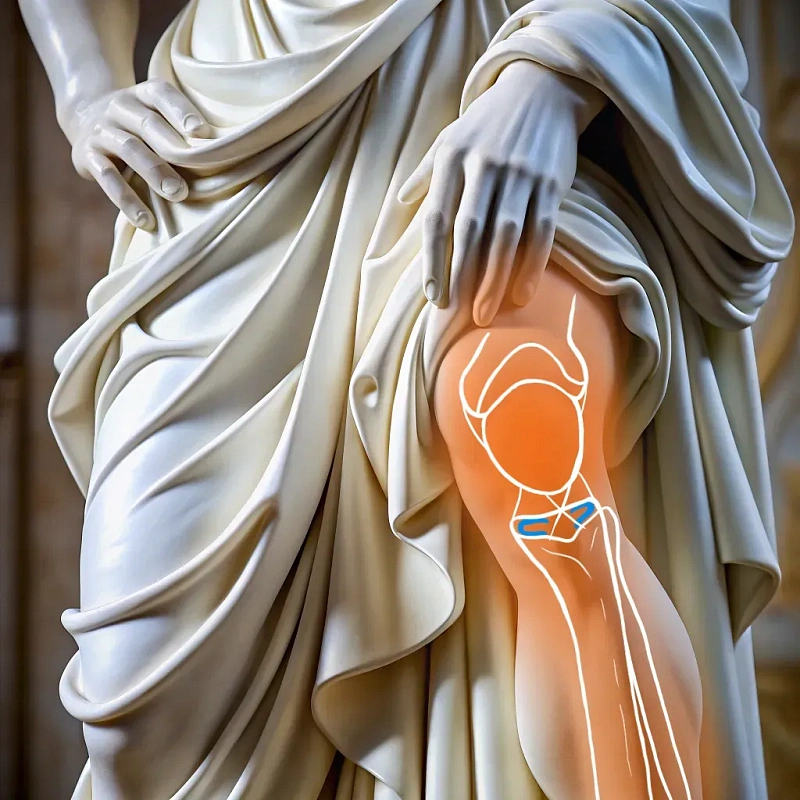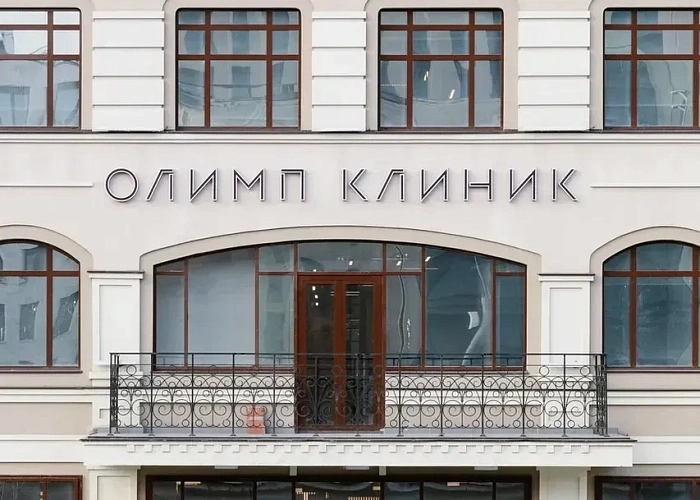Plastic medial holder of the patella
Dislocation of the patella occurs at the moment of twisting in the joint and displacement of the kneecap: falling to the knee, hitting the straightened leg in the knee area. A gentle method of surgical treatment is arthroscopic intervention.

The mechanism of injury occurs as follows: the knee turns inward, the retaining muscle is sharply stretched. As a result, the internal restraint breaks and dislocation occurs. With repeated traumatization, osteoarthritis may develop.
Restoration of the integrity of the ligaments is performed using arthroscopic plastic surgery. During the operation, the patella "returns" to its place, the anatomical integrity of the joint is restored. Plastic surgery of the medial patellar retainer is performed by experienced sports orthopedic traumatologists and surgeons, which guarantees high efficiency of the procedure.
Clinical analysis of blood and urine Radiography of the knee joint Magnetic resonance imaging (MRI) Consultation with a therapist and specialized specialists such as an orthopedic traumatologist and an anesthesiologist
On the day of the operation, the patient is hospitalized in the morning, and laryngeal mask anesthesia is performed. A camera with instruments is inserted into the joint through micro-injections, with the help of which the condition of internal structures is assessed and the necessary manipulations are performed. The surgeon carefully adjusts the medial patellar retainer by strengthening existing ligaments or creating new ones fr om the patient's tissues or surgical materials. After the operation, the patient is transferred to the awakening room, wh ere his condition is monitored by medical staff. The operation lasts an average of 60-90 minutes.
Arthroscopes with high-quality optics Miniature surgical instruments
For the first 3 weeks, the knee joint is fixed in a straight orthosis, and the movement is carried out with the help of crutches. Then therapeutic gymnastics and physiotherapy (magnetotherapy, UVT, kinesiotaping, massage) are performed with a gradual increase in the load on the knee. After 4 weeks, a gradual transition from crutches to a cane begins, and then to walking without support. Full recovery takes 3-4 months.
Benefits
Precise correction
Return to the correct position of the patella.
Minimal invasiveness
The use of low-traumatic surgical techniques.
Fast recovery
Modern methods of treatment and rehabilitation contribute to a quick return to normal life.
Long-term result
Achieving a long-lasting effect of knee stability.
Preparation for plastic surgery of the medial patellar retainer
Before surgery, the patient undergoes a full medical examination, including an MRI or ultrasound of the knee joint, for accurate diagnosis and planning of surgical intervention. It is important to discuss with your doctor all the potential risks and expectations of surgery.

Plastic surgery of the medial patellar retainer
The surgeon makes several small incisions around the knee joint to insert arthroscopic equipment — a thin tube with a camera and a lighting device at the end. During the operation, the surgeon carefully adjusts the medial patellar retainer, strengthening existing ligaments or creating new ones from the patient's tissues or surgical materials.

Recommendations after plastic surgery of the medial patellar retainer
After surgery, the patient may be advised to wear an orthopedic splint to stabilize the knee, as well as perform exercises under the guidance of a physiotherapist to restore strength and mobility of the joint. It is important to avoid intense stress on the knee during the first weeks after surgery.

Specialists
Find a SpecialistIndications and contraindications
Indications
Injuries to the medial retainer
Ruptures or sprains that require surgery to repair.
Patellar deformities
Anatomical abnormalities that lead to a violation of its function and position.
Chronic instability
Permanent dislocations or subluxations that interfere with normal life activity.
Pain syndrome
Chronic knee pain associated with patellar dysfunction.
Expected effect
Restoring knee stability
Reduction or elimination of dislocations and subluxations of the patella.
Improving joint functionality
Return to sports and daily activities without restrictions.
Reducing discomfort
Relief of knee pain that occurs during movement or exertion.
Prevention of degenerative changes
Slowing down the development of osteoarthritis and other degenerative diseases of the knee joint.
Similar referral activities
Arthrodesis of the joints of the fingers of the hand
The destruction of the joints of the fingers of the hand is accompanied by pronounced pain and impaired functions. Arthrodesis is a surgical intervention in which the affected joint is completely immobilized, which relieves pain and progression of inflammation.
Arthroscopic revision of the cystic joint
The condition of the wrist joints determines the functioning of the hand. Arthroscopic revision is a minimally invasive diagnostic procedure that assesses the condition of the joint tissues, which is necessary for planning subsequent treatment.
Osteosynthesis of the bones of the fingers of the hand
The osteosynthesis of the bones of the fingers of the hand due to the comparison and fixation of the ends of the fragments ensures rapid rehabilitation and proper fusion.
Osteosynthesis of the bone of the wrist
The pathologies of the wrist joint are engaged in pathologies of the wrist joint. With damage to the bones, it will perform the osteosynthesis procedure.
Остеосинтез кости запястья
Патологиями области лучезапястного сустава занимается кистевой хирург. При поражении костей запясться он выполнит процедуру остеосинтеза.
Admission of an orthopedic traumatologist
Assessment and diagnosis of diseases of the musculoskeletal system. An orthopedic traumatologist conducts an examination, evaluates the functionality of the musculoskeletal system, prescribes the necessary studies and develops a treatment or rehabilitation plan.
How to reach
How to get
From the Belorusskaya metro station of the Zamoskvoretskaya line - exit 4 After exiting the subway, walk through the pedestrian tunnel and climb the stairs. Move towards the railway tracks, go down the stairs immediately after them and walk along the house, then turn right onto 1st Yamskoye Pole Street. At the turn to 3rd Yamsky Pole Street, cross the road at the pedestrian crossing and continue along 1st Yamsky Field Street, after a few buildings on the left you will see Olympus Clinic MARS.
Travel time
9 minutes
Landmark
Olympus Clinic MARS sign
How to get
From the Belorusskaya metro station of the Ring line - exit 2. After exiting the subway, turn left and walk to the pedestrian crossing. Cross the road through two pedestrian crossings and move along the Tverskoy overpass. Go down the stairs immediately after the railway tracks, walk along the house, then turn right onto 1st Yamskoye Pole Street. At the turn to 3rd Yamsky Pole Street, cross the road at the pedestrian crossing and continue along 1st Yamsky Field Street, after a few buildings on the left you will see Olympus Clinic MARS
Travel time
11 minutes
Landmark
Olympus Clinic MARS sign
From the metro station "Tsvetnoy Bulvar"
1 exit to the city, then left to the Garden Ring, at the crossing to the right, crossing the boulevard, one more crossing and at the traffic light to the left. The Olymp Clinic building is located overlooking the Garden Ring to the right of the crossing. Travel time is approximately 9 minutes. Landmark - sign Olymp Clini
From the metro station "Sukharevskaya"
Exit 3 from the metro and 640 meters straight ahead, the clinic will be on the right. Landmark - sign Olymp Clinic
Parking lot map
Exit 3 from the metro and 640 meters straight ahead, the clinic will be on the right. Landmark - sign Olymp Clinic

From Sokol metro station
The last car from the center: follow the signs for Exit 5. From the glass doors to the right and go to the end of the passage. Exit to the city by the steps to the left. After exiting the crossing to the street, go straight along Leningradsky Prospekt to the intersection with Chapaevsky Lane. Next, turn right (onto Chapaevsky Lane) and walk to the Triumph Palace residential complex. Entrance to the territory: through checkpoint No. 1, opposite the Vkusville store, you will need to present your passport. After passing through the checkpoint, go up the stairs to the fountain, opposite it you will see our clinic.
Travel time
10-12 minutes
From the Airport metro station
The first car from the center: follow the Exit 2-3 signs. Turn left out of the glass doors and walk to the end of the passage. After exiting the crossing to the street, go straight along Leningradsky Prospekt to the intersection with Chapaevsky Lane. Next, turn left (onto Chapaevsky Lane) and walk to the Triumph Palace residential complex. Entrance to the territory: through checkpoint No. 1, opposite the Vkusville store, you will need to present your passport. After passing through the checkpoint, go up the stairs to the fountain, opposite it you will see our clinic.
Travel time
12-15 minutes
How to get
Entry to the territory is prohibited, but there are free city parking lots around the Triumph Palace residential complex, where you can easily find a place for your car. Free parking area:



